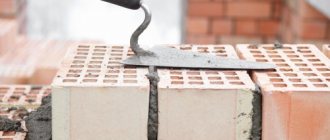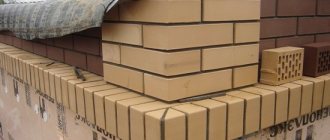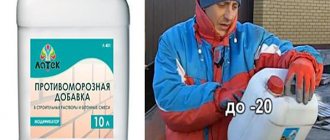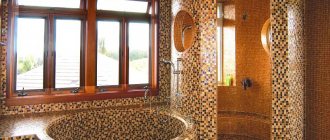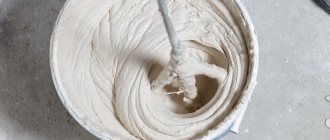The process of making decorative masonry from special grades of bricks often faces the problem of inexpressiveness of the color scheme. Despite the relatively large number of colors and shades of facing bricks, most often the customer and the contractor argue about the color of the resulting building; one building can have too different shades and colors, even from the same batch of bricks.
For what purposes was the colored solution invented?
In addition to the unpleasant effects of lime or salt efflorescence on a red or dark background, the color and shade of the bond joint can radically change the shade, overall impression and perception of colored masonry. Craftsmen involved in decorative masonry know firsthand about the insidious effect of darkening the original color of a wall. The rich fiery red or beige color of the brick acquired a grayish tint upon completion of the masonry.
The reason is the gray or dark gray color of the brickwork joint. Approximately 15% of the surface of a brick wall is occupied by the joint surface, gray and featureless. The bright shade of the finished building can be darkened by even 3% of street dust that has settled on the brick, and 15% of a gray seam can completely ruin the appearance of the building.
To prevent loss of shades, experienced craftsmen take some measures in advance:
- The interbrick joint is grouted with grout mixtures of various colors and compositions;
- A brick wall is painted with special colored compounds that reveal the color and, often, give the brick texture water-repellent properties that prevent efflorescence and discoloration;
- They use a colored mortar for laying bricks; after jointing and contouring the seam, the required color and shade of the entire brick building is achieved.
For your information! Despite the fact that there are only five basic pigments for producing a colored binder, in practice, using additives in bricklaying mortar, it is possible to obtain about 30 individual colors and shades.
Using the capabilities of colored solutions
The ability to manipulate the color characteristics of brickwork or even individual sections of a wall makes it possible to professionally emphasize the beauty of the texture of the material, especially in the rays of the setting or rising sun.
In what cases is it preferable to change the color of the seam?
By choosing the color of the seam, it can be highlighted with maximum contrast, strength, or, conversely, merged into one color with the brick. In both cases, the effect is achieved by using special mineral paints and a couple of compounds that prevent the loss of astringent properties and protect the coloring pigment from destruction and leaching.
Contrast is a universal way to emphasize the expressiveness of masonry
White mortar for bricklaying has always been and will remain the champion in efficiency and expressiveness. In combination with any shades and colors except yellow, it allows you to visually make masonry on colored mortar light and bright. The question of how to make white mortar for bricklaying always depends on the economic feasibility of such an undertaking.
The white color of the masonry seam can be obtained:
- adding excess slaked lime;
- zinc oxides;
- titanium oxide.
The latter compound produces an exceptionally high-quality white color that is resistant to oxidation for ten years. Previously, white lead additives were used, but due to the toxicity of lead, its use was abandoned long ago.
The high cost of titanium salts often forces one to resort to trickery. To obtain a colored seam, two different types of mortar are actually used. The first is the usual one based on a cement-sand mixture. The second is a colored, white composition that is mixed based on white cement M-500 with the addition of a coloring pigment. Brick laying is done using both mortars. The entire area for laying bricks is filled with the first mixture, not reaching the outer edge of the wall 2-3cm. The space left for the outer part of the seam is carefully filled with a colored - white solution.
In addition to excellent frost resistance, white cement has a dense structure and retains moisture very well, which prevents the penetration of some of the salts of the usual solution onto the wall surface in the form of stains and efflorescence.
Types of Dyes
The most common dyes are acid-based. Their features:
- found in all popular colors;
- used for facade work and interiors;
- sprayers or a special brush (without metal elements) are used for application;
- after treating the cement, the remaining acidic environment is washed off with water;
- the compositions are wear-resistant, resistant to fading and burnout.
It is better to use water-based acrylic paints for bricklaying; they have a richer color variety and are inexpensive. If the desired color is not available, you can mix several formulations. The acrylic-based color easily penetrates into the concrete and does not need to be washed off. The end result will be rich and long-lasting color.
Read also: How to keep laying quails at home
At home, colors are often used to create paving stones. The solution with the addition of pigments is poured into molds and the material is allowed to dry completely. If you are wondering whether it is possible to lay such paving stones in places with high traffic, definitely yes, because they are not inferior to commercial options.
The use of colored solutions to mask masonry seams
In addition to contrasting the line of brick laying, a colored binder can be used to completely hide the structure of the wall. At the same time, the mortar joint itself has an absolute color match with the color of the facing brick. When the seam is cleaned, it is leveled flush with the bricks and, after drying, even follows its texture. The wall may look like a monolith or have a completely different pattern, a larger grid of blocks made of several bricks, or specifically outlined and shaded.
And often this is not a whim of the artistic imagination of the home owner. Experts recommend a similar technique to increase the thermal insulation characteristics of walls. In addition, the main problems with cracking of beautiful ceramic bricks are associated with the intensive absorption of moisture by the masonry through the mortar joint recessed into the wall.
The leveling technique is effective, but requires considerable effort and knowledge in accurately selecting the composition of the colored binder. As the colored seam dries, it lightens. Moreover, under the influence of the sun and rain moisture, part of the coloring pigment may fade, which is why a thin mesh of the seam appears against the background of the wall, but clearly visible from a distance.
Specifics of preparing colored solutions
To produce rich and bright colors, metal salts are most often used - iron, nickel, chromium, cobalt, copper. They are stable and resistant to heat and low temperatures. In addition to the coloring pigment, it is important to choose the right supporting base for the color mixture, usually white cement in bright colors or slag Portland cement for dark, almost black colors. The most durable brands have a distinct dark, almost black color, which helps to obtain a black mortar for bricklaying.
Previously, carbon black additives were used for black or very dark colored compositions, but, as it turned out, amorphous carbon greatly reduces the strength of the solidified solution due to poor wetting; now the carbon black has been replaced with complex iron salts.
Let's prepare a colored solution with our own hands
The main difficulty in preparing a colored solution is the exact dosage of the dye into the mother white or gray solution. Often, a colored solution acquires its true shade only after prolonged stirring and complete dissolution of the dye. Therefore, before mixing the main portion of the colored solution, several test mixtures are performed with different amounts of dye and water. The pigment itself must first be dissolved in warm water, with a slight settling of undissolved grains of dye.
Next, a dye solution, half of the cement and a third of the amount of sand are poured into a mixer or hand mixer in small portions. As the solution is beaten and mixed, the rest of the cement and sand is added. Typically, the total amount of pigment added to the solution is not recommended to exceed a tenth of the M100 solution and 1/12 for M75-M45.
Advice! If you need a complex shade of a colored solution, it is better to use a branded colored solution; your own experiments will often require a large number of experiments and test batches, which will cost several times more.
How to make colored mortar for bricklaying
Colored mortar for bricklaying.
Decorative brickwork creates a unique exterior design. The problem sometimes is that the seams do not match the color scheme. This issue will be solved by colored brick mortar. The shade of brick varies due to batches.
Colored and white mortar for bricklaying.
Is colored solution really necessary?
Only the standard gray color of masonry mortar was used in construction. This disrupts the picture and spoils the appearance of the facing brick when laying. Unpleasant effect of the mortar: the appearance of efflorescence on the brick due to exposure to moisture. After complete drying, the shade of the masonry seam itself changes, which does not look right. Some types of facing bricks absorb moisture with cement, which gives bright shades a grayish color. The gray seam area occupies up to 15% of the masonry area. This is an indicator that makes adjustments to the color palette. Along with the seam, dust that constantly settles on the surface can spoil the appearance.
The problem of fading of facing bricks is solved in several ways. Experienced craftsmen use the following tricks: using grout; painting; colored solution.
Grouting the joints of tiles or other tiles is common. In this case, a shade is selected that best suits the tile. Some craftsmen do the same for facing bricks. Grouting composition for an attractive appearance of the seam. The procedure takes some time. The option is not so scrupulous, but there will also be material consumption. Apply the composition to the plane of the wall.
At the same time, the seams change color, the shade of the brick. The seams highlight the brick and the material acquires an additional water-repellent effect. This reduces the likelihood of efflorescence. The last method is preparing masonry mortar of a suitable color. There is no need to periodically update the seam. The color lasts over time.
Basic five pigments to obtain the shade of the solution. This does not mean that you should limit yourself to this. With the correct ratio, they produce up to 30 shades that will suit the masonry.
The correct color shade for a specific type of facing brick improves the appearance and allows you to create a look depending on the time of day. The length of the sun's rays plays a role, so the building will shimmer and highlight the specific color that it looks like. Ways to highlight a brickwork seam: underlining; contrast; merger.
The first way is to highlight the shade of brick by an architect. The shade of the joint is darker and duller than brick, which will allow the blocks to play with shades. Contrasting pigment creates a combination based on opposition. In this case, it is important to use colors that are consistent with the palette, but with shades. The last type of pigment selection allows you to create a one-color plane. In this case, the seam does not stand out against the background of the brick.
Contrast solution.
White dye is added to the solution. This is with contrasting properties. With facing brick it stands out. At the same time, the masonry becomes visually lighter. This does not apply to the light yellow shade of brick. Some customers do not agree to use a white solution because the final cost is expensive. To prepare this kind of composition you will need:
slaked lime; zinc oxide; titanium oxide.
Substance for preparing white mortar for masonry titanium oxide. This has to do with properties. Able to retain color for years. At the same time, it does not darken under the influence of precipitation. The dye used was substances that contained lead. The metal has harmful emissions that negatively affect human health. Therefore, this idea was abandoned.
The trick is to save money by preparing a white solution.
Laying bricks not for the volume of white mortar that is required, but for a portion. For these purposes, a cement composition is prepared, which is laid on the brick in such a way that there is a gap that goes to the front side of the wall. Part of the white composition that is placed on the space. To make the second one, you will need M-500 cement and a colored pigment, which are mixed in such proportions to create a shade. The advantage of using a contrasting white solution is that rainwater efflorescence does not appear. In addition, such a masonry mortar resists the penetration of moisture inside, since the structure is dense.
Colored solutions.
In addition to the contrast, the effect of merging during brick laying.
In this case, the pigment matches the color of the brick. At the same time, it is possible to visually hide the structure of the wall. The seam itself is processed. The seam is flush with the blocks. Some craftsmen ensure that the texture of the seam follows the surface of the brick. The seam is buried to a minimum depth, then the effect of the building is monolithic.
During laying, choose the correct location of the seam in relation to the edge of the brick, as well as the thickness. If these nuances are not observed, then the moisture absorption area will easily increase, which will lead to partial cracking of the bricks during operation. A person with experience in construction can suggest such nuances. When selecting pigment for a colored seam, an accurate calculation of the quantity is required. It is important. The solution dries out and loses some of its color and becomes lightened, which disrupts the harmony. The pigment may be partially washed out by rainwater or fade under the influence of ultraviolet radiation.
Available pigments.
Black. Grey. Dark grey. Brown. Red-brown. Chestnut. Beige. Light ocher. White.
For the color of the solution, powders of metal salts. For these purposes the following is used:
iron;
chromium;
cobalt;
copper.
Popular due to physical properties. Salts of these metals tolerate temperature changes and exposure to precipitation. Pigment is an additive substance, so choose the right components for the base. Only in this case will the pigment gain color. For bright colors, white cement is often used. If the shade is darker, then Portland cement will do. To obtain a black color, use grades of cement with strength.
Instead of iron salts, soot was previously used to obtain black color. Over time, it became clear that amorphous carbon negatively affects the strength of the solution - it reduces it. This is due to the fact that moisture penetration occurs insufficiently. The soot was replaced with a combination of several salts.
Cooking method.
The first problem that you will have to face when preparing a colored mortar for masonry is the dosage of pigment in a white or gray base. Mix the composition thoroughly during preparation, since the full shade is gained only after the dye has completely dissolved. The risks are small. Preliminary mixing with the amount of dye and water. The dye should not be poured into the solution in powder form. It is better to pre-dissolve it in warm water. At the same time, remove the particles.
into a concrete mixer, load into the mixer container in order:
1. pigment;
2. half the amount of cement;
3. a third of the sand.
The pigment solution is partially poured in immediately and then added along the way. Next, the rest of the cement and sand is added. The pigment in the solution is present no more than a tenth for the M-100 brand and a twelfth part for the M-75 brand. Ready-made solutions with pigments for masonry. It is better to take it when you need to prepare a mixture with a complex shade. The finished solution will cost less, because for manual preparation there is an overconsumption of components due to trial batches.
Craftsmen, with experience in using colored mortars for masonry, develop their own solutions for the appearance of buildings. Use of a fluorescent component. It is not added separately, but glass powder is used for this. The result is the glow of the seam mesh after sunset. The effect manifests itself over several hours.
A seam that will respond to changes in ambient temperature. To do this, the seams are rubbed with a solution with the addition of a composition. As the temperature drops, the composition acquires a blue tint, and when it rises, the tint acquires soft tones that are closer to red. An endless supply of ingredients to color your masonry mortar. During experiments, select components that will not affect the quality and strength of the solution.
The nuances of preparing colored mortar for masonry. It is important to be judicious in the quantity and quality of pigment. Apply a portion to the brick and see how it looks after it dries completely. Only this way will you be satisfied with the end result.
Innovations in the use of colored masonry mortars
The desire to give the walls of a house a refined and slightly pretentious look pushes craftsmen to come up with unusual solutions in the use of colored solutions. A small addition of finely ground glass powder with a fluorescent component makes the grout mesh glow against the background of dark brick for several hours after sunset.
Another unusual application is to grout colored mortar joints with a mixture that changes color depending on the ambient temperature. Thus, as the wall made of facing bricks warms up or cools down, it can change its shade and texture pattern.
Such things can be called eccentricity, but practice shows that there are plenty of people who like to decorate their homes in the most unusual way, which means there will always be a couple of fresh proposals to meet the demand.
Characteristics and properties of pigments
When choosing which paint to add to the cement mortar or use to paint an already finished surface, you need to carefully study all the parameters and features.
Required qualities
In order for the paint to distribute well over the surface or solution, give the intended color, and guarantee its durability, it must meet certain requirements.
What paint can be used to paint cement/concrete:
- Fraction – relevant for powder dyes and other types. The smaller the particles in the pigment, the more reliable and uniform the color will be, and the surface to be painted will cover well.
- Sensitivity to light - the ability to maintain the saturation of the shade without changes, without fading. Particularly important for paints used on the exterior of buildings.
- Oil holding capacity is the ability of a composition to hold a volume of oil.
- Resistance to alkali – determines the characteristics of the contact of the pigment with cement.
- Corrosion resistance.
- Comfort in use - the less tools you need to use and manipulations, the easier the paint will be to use.
- Ensuring you get the right color is also very important. The shade may vary within small limits depending on the color of the cement and other parameters, but in the end it should be the same as specified by the manufacturer.
Primary dye colors
The color of concrete or the surface being painted directly depends on the shade of the pigment and the characteristics of the interaction of substances in the composition. This parameter is largely influenced by the color of the cement - so, for the brightest and most accurate shade, choose white; for muted colors, gray is also suitable.
For most manufacturers, pigment colors are limited to basic shades - blue, red, green, black, yellow. By combining them in the right proportions, you can get orange, purple and other secondary shades. To create a white solution, white Portland cement and filler of the same color are used in its mixing. Titanium dioxide can be used to lighten gray cement.
What affects the resulting color:
- The shade of sand, other fillers - the darker the color, the more saturated and less bright the result will be. Bright color can be achieved using transparent quartz sand, light crushed stone, and white cement.
- Water-cement ratio - the more water, the lighter the solution and the brighter the color.
- Concrete hardening temperature - at high temperatures, the crystals formed during the hardening process of the mixture are smaller, light is scattered through them better and the shade appears lighter.
- The percentage of pigment in the total mass - before painting the cement mortar, you need to study the instructions for the dye. Color is added to the solution in a volume of 8-10%, no more. Active coloring compounds are administered in a volume of 5%. Further, the difference in shade will not be very noticeable, but the characteristics of the concrete may deteriorate. Typically, pastel colors require the addition of 1-3% of the total mass, medium in intensity - about 3-4%, the brightest and most saturated - 4-6% or more.
- Manufacturer - production method, accuracy of adherence to technology, raw materials used can give different results for the same color of pigments from different manufacturers.
- Time - the duration of operation is determined by the composition and method of dyeing: oxide dyes retain their shade for a very long time, for example. Over time, limescale stains (efflorescence) may appear on painted surfaces.
Read also: Lifestyle of an earthworm in brief
The most popular colors for coloring cement:
- Green – from chromium oxide
- White – titanium dioxide
- Yellow – from iron oxide of the corresponding color
- Red - from iron oxide of this shade
- Black – made from black iron oxide
How to choose the right cement
The impact of mortar and surface paints depends largely on the type of binder used. The technology allows you to use any brand of cement, but the color of the powder affects the resulting shade.
Rules for coloring cement:
- Gray Portland cement, when hardened, becomes dark gray with a dirty undertone, muting the bright colors.
- White cement has almost no effect on color change and is most suitable for obtaining a bright and rich, light shade.
The coloring composition also influences the result - the type of pigment determines the depth and saturation of the shade. To know exactly what will happen in the end under specific conditions and materials, it is better to do a test - a trial batch. One way or another, the concentration of pigment in concrete cannot be exceeded; this will negatively affect the quality and strength of the solution - cracks may appear and the hydration process will be disrupted.
Types of dyes
To make cement or concrete colored, you can use a variety of coloring options. Much when choosing depends on what is being painted and for what operating conditions (sculpture or garden path, concrete blind area or basement of a house, etc.).
Acid dyes
Acid stain is a ready-to-use substance that reacts with already hardened concrete, creating insoluble deposits of the original colors in the pores. The pigment does not create a film, penetrating into the monolith to a depth of about 1 millimeter and becoming, as it were, part of it, strengthening and binding the surface (thereby increasing wear resistance and extending service life).
Acrylic dyes
The safest type of dye for humans - it allows work in the fresh air and indoors. Dries quickly and can be painted several times to achieve the desired shade. This is the most accessible and cheapest option for painting walls, which guarantees excellent color saturation for a long time.
Dry dyes
Dry dye is applied to fresh concrete in a thick layer with a trowel; it requires certain skills or at least training on a test surface. Offers a large selection of shades that are resistant to various negative factors (weather conditions, temperature changes, ultraviolet radiation).
When choosing a dry pigment, you need to pay attention to the uniform color and uniformity of the composition, since the substance cannot be dissolved with water. Apply the substance with a spatula or trowel in an opaque dense layer.
Simple dye
You can even make simple dyes yourself. They are usually made in powder format and offer a wide range of shades. When choosing, you must pay attention to the quality of the substance, since low-quality dyes quickly fade under ultraviolet light, do not tolerate weather conditions well and require constant touch-up.
As a rule, simple dyes are most often used to decorate rooms. To obtain the finished composition, mix the powder with a solvent (rarely water), then apply and wait until it dries completely.
Color additives
Dyes of this type allow you to paint concrete at the stage of mixing the solution. Additives in powder or liquid form are added to the mixture, most often in pastel colors and light shades. The dye does not wash out and lasts as long as a concrete structure. The choice of options is large, the operating technology is simple.
Colored cement is a great opportunity to give any structures and surfaces a decorative look and individuality. Provided that high-quality pigments are used and technology is followed, concrete coloring will not only achieve the desired effect, but also strengthen the monolith itself and improve its performance characteristics.
Read also: How radishes grow photo
How to make your own concrete dyes? Not all concrete products are dull and gray. Today, there are technologies that make it possible to give this building material absolutely any shade by adding various dyes to its composition. Colored concrete is used in the manufacture of paving slabs, garden borders, cement and sand paving stones, side stones and other materials. Such building material can be easily used during the construction or renovation of your own private home.
One of the common options for painting concrete is the processing of finished products, using deep-penetrating paints that paint concrete to a depth of up to 2 mm.
With the help of dyes, it is possible to transform concrete from a boring and gray material into a rather interesting and original one. There are a large number of painting methods, each of which has its own advantages and disadvantages.
